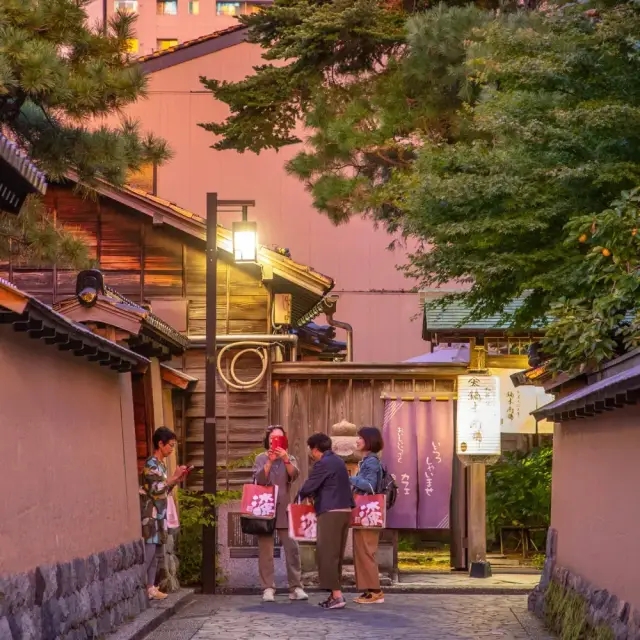https://www.dekitabi.com/itinerary/kanazawa-nagamachi-nishi-chaya-tour
Kanazawa, a city rich in historical and cultural heritage, offers visitors an immersive experience into Japan’s samurai era and traditional culture. This guide highlights key attractions in Kanazawa that bring the past to life, including Oyama Shrine, Kanazawa City Ashigaru Museum, Samurai Residence Ruins Nomura Family, Nagamachi Samurai Residence Ruins, and the intriguing Ninja Weapon Museum.
Oyama Shrine: A Fusion of Cultures and History

https://www.dekitabi.com/attraction/oyama-shrine-kanazawa
Nestled in the heart of Kanazawa, Oyama Shrine is a striking example of Japan’s religious and architectural heritage. Founded in 1599 to honor Maeda Toshiie, the first lord of the Kaga Domain, Oyama Shrine stands as a symbol of Kanazawa’s deep-rooted history. The shrine’s main hall features a unique blend of Japanese and Western architectural styles, showcasing its evolution through time.
One of Oyama Shrine’s most notable features is its iconic gate, built in 1875, which combines traditional Japanese aesthetics with modern influences. The gate’s intricate woodwork and lattice design offer a visual feast for visitors. Inside the shrine, the tranquil atmosphere invites reflection and admiration of its beautifully maintained grounds and ancient trees.
Visitors to Oyama Shrine can also enjoy seasonal festivals and events that provide a glimpse into traditional Japanese celebrations and rituals. These events, coupled with the shrine’s serene environment, make Oyama Shrine a must-visit destination for those interested in Japan’s cultural and spiritual heritage.
Kanazawa City Ashigaru Museum: A Glimpse into the Life of Foot Soldiers

https://www.dekitabi.com/attraction/ashigaru-museum
The Kanazawa City Ashigaru Museum offers an in-depth look at the lives of ashigaru, the foot soldiers who played a crucial role in Japan’s feudal era. Located in the heart of Kanazawa, this museum provides a comprehensive overview of the social and military aspects of these often-overlooked historical figures.
The museum’s exhibits include detailed dioramas, authentic samurai armor, and weaponry that illustrate the daily life and combat skills of the ashigaru. Visitors can explore interactive displays that highlight the ashigaru’s training, duties, and contributions to the samurai class. This museum offers a fascinating contrast to the more glamorous image of the samurai, shedding light on the broader spectrum of feudal Japanese society.
Educational programs and guided tours are available for those seeking a deeper understanding of the ashigaru’s role in shaping Japan’s history. The Kanazawa City Ashigaru Museum is a valuable resource for history enthusiasts and anyone interested in the complexities of Japan’s military past.
Samurai Residence Ruins Nomura Family: A Glimpse into Samurai Life

https://www.dekitabi.com/attraction/nomura-ke-samurai-residence
The Samurai Residence Ruins Nomura Family, located in the Nagamachi district, offer a fascinating insight into the lifestyle of the samurai class. This historical site preserves the remains of the Nomura family’s residence, providing a window into the domestic life of samurai during the Edo period.
Visitors to the Nomura Residence will find well-preserved features such as traditional tatami rooms, elegant sliding doors, and an exquisite Japanese garden. The residence’s design reflects the aesthetic values and social status of the Nomura family, offering a tangible connection to Japan’s samurai heritage.
The surrounding area of Nagamachi, with its narrow streets and historical architecture, further enhances the experience of stepping back in time. Exploring the Nomura Residence and its surroundings provides a vivid picture of the samurai’s refined lifestyle and their role in Japanese society.
Nagamachi Samurai Residence Ruins: Echoes of a Bygone Era

https://www.dekitabi.com/attraction/nagamachi-samurai-district
Adjacent to the Nomura Residence are the Nagamachi Samurai Residence Ruins, which offer additional insights into the samurai way of life. This area features the remnants of various samurai residences, each showcasing the architectural and cultural aspects of the time.
The ruins provide a poignant reminder of the samurai’s former presence in Kanazawa, with structures that reveal the layout and design of traditional samurai homes. The Nagamachi district itself retains much of its historical charm, with preserved buildings and streets that transport visitors to the Edo period.
Walking through the Nagamachi Samurai Residence Ruins allows visitors to appreciate the scale and elegance of samurai architecture while reflecting on the daily lives of those who once inhabited these spaces.
Ninja Weapon Museum: Unveiling the Secrets of Stealth and Strategy

https://www.dekitabi.com/attraction/ninjabuki-museum
For those intrigued by Japan’s ninja culture, the Ninja Weapon Museum is a must-visit destination. Located in Kanazawa, this museum explores the world of ninjas—skilled spies and assassins known for their stealth and combat expertise.
The museum’s collection includes an array of ninja weapons, such as shuriken (throwing stars), kunai (daggers), and various other tools used for espionage and combat. Exhibits also cover the techniques and tactics employed by ninjas, offering visitors a comprehensive understanding of their role in Japanese history.
Interactive displays and demonstrations provide an engaging experience, allowing visitors to see the ninja’s tools and techniques in action. The museum’s informative exhibits make it an educational and entertaining stop for those fascinated by the covert aspects of Japanese history.
Conclusion
Kanazawa offers a rich tapestry of historical and cultural experiences, from the serene Oyama Shrine to the intriguing Ninja Weapon Museum. Each site provides a unique perspective on Japan’s past, whether through the lens of samurai life, the daily experiences of ashigaru soldiers, or the stealthy world of ninjas. Exploring these attractions offers a deeper appreciation of Japan’s heritage and the diverse stories that have shaped its history.


Leave a Reply